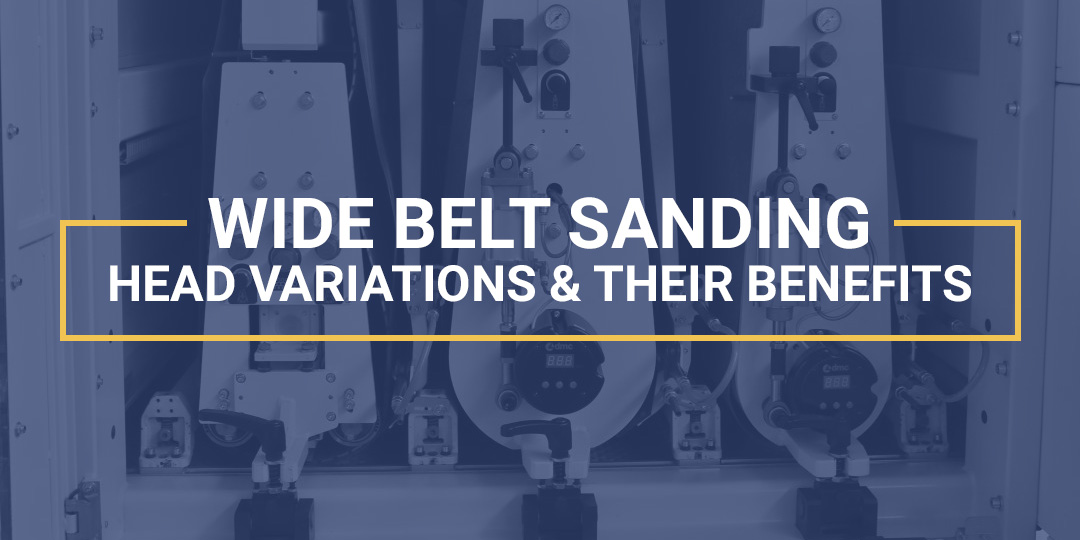
Wide belt sanders are specialty woodworking machines designed to sand wooden pieces down to a specific thickness and finish. Their versatility makes it easy to use multiple grit types on a single project, they cover a greater surface area (which means less loading), and they usually come with a platen, which gives your workpiece that final finish before you stain the surface or apply a random orbit sander.
The performance of a wide belt sander can vary according to the type of sanding head it uses. In this blog, the team at Fintech Abrasives reviews four main varieties of sanding heads and a hybrid version that can be used for any type of sanding head with a polishing platen.
1. Contact Drum Head
Contact drum heads are found in most wide belt sanders, making them the most commonly used of the four different types. They range in size from 4” to 18” in diameter and can accommodate a hardness of up to 95 durometers in rubber. Steel versions are also available.
These drum heads can be used for anything from shaping and cutting down to intermediate sending and, in some applications, finishing. They use a line contact to interface with the part being sanded and exert significant pressure. Regular maintenance is necessary to avoid chatter marks during use.
2. Drum and Platen Head Combination
These sanding heads combine a contact drum and polishing platen within the same sanding belt. You can adjust them to sand with either the drum, the platen, or both, which contributes to a more rounded performance.
Although versatile, this type of combination head has two distinct downsides:
Minimum part lengths are longer due to the extended distance between hold-down shoes or pinch rolls.
Platen-type sanding heads have a tendency to create streaking.
A platen interfaces with the part being sanded with a flat surface, exerting low pressure.
3. Polishing Platen Head
Polishing platen heads (also known as smoothing bars) were originally designed to eliminate the belt splice marks and chatter marks that contact drum sanding heads tend to produce. Using a polishing-type finish, they refine the grit marks and scratches created by previously-applied sanding heads. Instead of the line contact obtained on contact drum heads, platens apply a large and flat surface to the part being sanded, resulting in the following benefits:
A longer scratch line due to the abrasive being in contact with the part for a longer time period.
A smoother finish no matter what grit belt you use, as the sanding dust is continually trapped between the workpiece and the abrasive, keeping the latter from penetrating as deeply.
No chatter marks because the platen is cushioned and doesn’t rotate.
Less likelihood of leaving belt splice marks because the entry and exit points for the abrasive belt are comparatively flat and won’t leave a mark should the belt be too stiff or the wrong specification.
On the downside, polishing platen heads are more likely to cause streaking. When dust is trapped between the workpiece and the abrasive belt, the likelihood of streaking goes up, especially when you apply higher pressures. The graphite pad and its cover are also susceptible to grooving and build-up, which can leave their own distinct streaking patterns.
4. Crossbelt Platen Head
Crossbelt platen heads have a comparatively narrow abrasive belt that runs at a right angle across a workpiece. Originally, these were solid one-piece platens, but modern machines have segmented platens.
Because they cut at right angles to the grain, crossbelt heads will cut more aggressively than wide belt platen heads. They are typically used to remove tape from veneered parts. They are also needed if you're sanding long parts with grain running perpendicular to the part length, such as desk front panels.
Segmented Platen Sanding Head Variation
Segmented platens can be applied on any sanding head with a platen. They are flexible, with enough yield to accommodate variations in workpiece thickness and surface.
Sanding heads of this type are ideal for sanding seals, lacquers, and veneers. They can also be used for sanding solid wood parts. However, if thickness dimensioning is needed, you’ll want a sanding head with less yield.
For Best Results, Use Premium Wide Sanding Belts
These sanding head variations are engineered for specific applications and results, but when it comes to wide sanding belts, there is one fundamental requirement: the abrasive has to be high quality and the right grit for whatever stage of the project you’re at.
Fintech Abrasives manufactures wide sanding belts of different sizes, with grits that include aluminum oxide and zirconia. We can even custom manufacture belts to meet your specific needs. If you would like to speak with an abrasive technician or place an order, you can contact us at any time by filling out our contact form or calling (888) 223-8768.